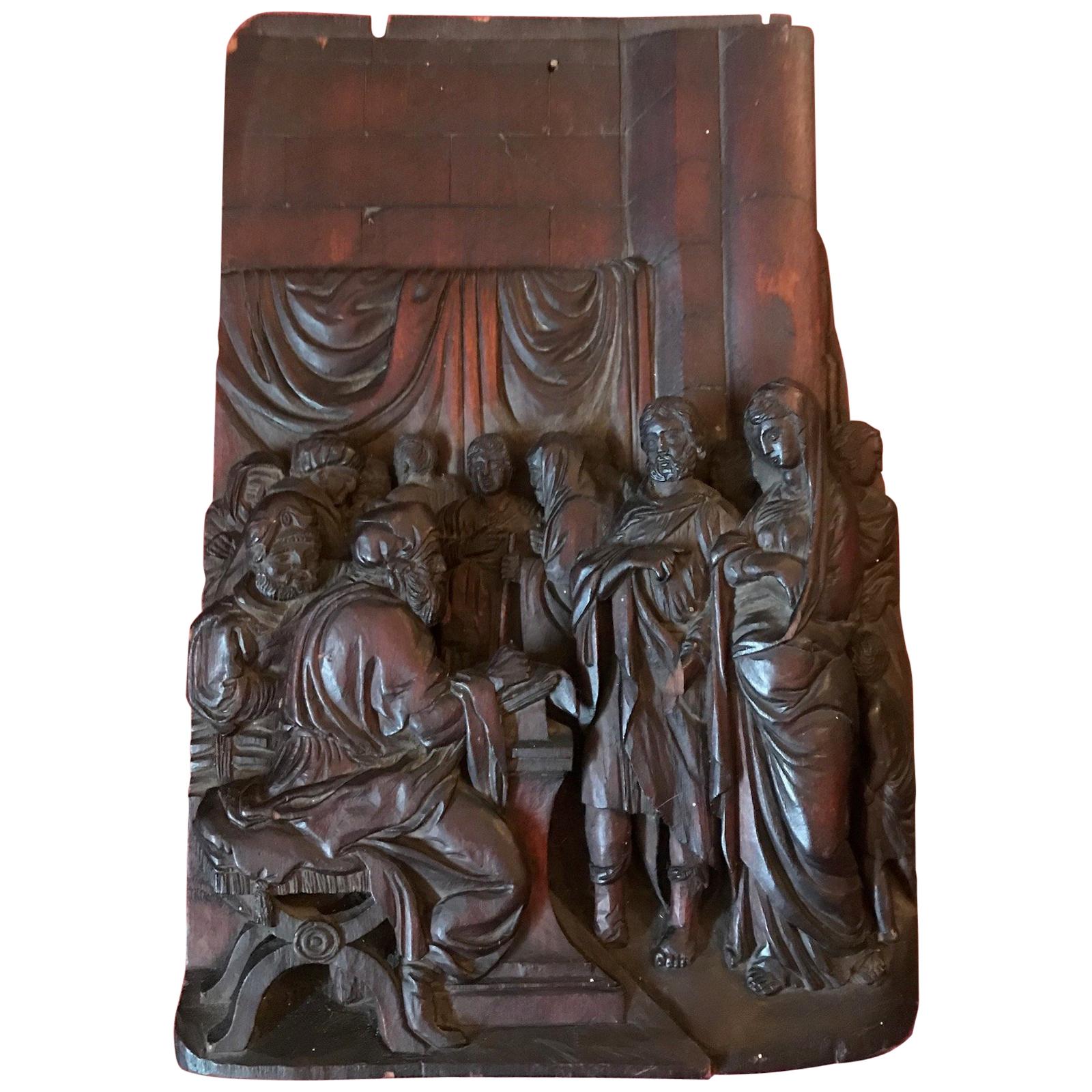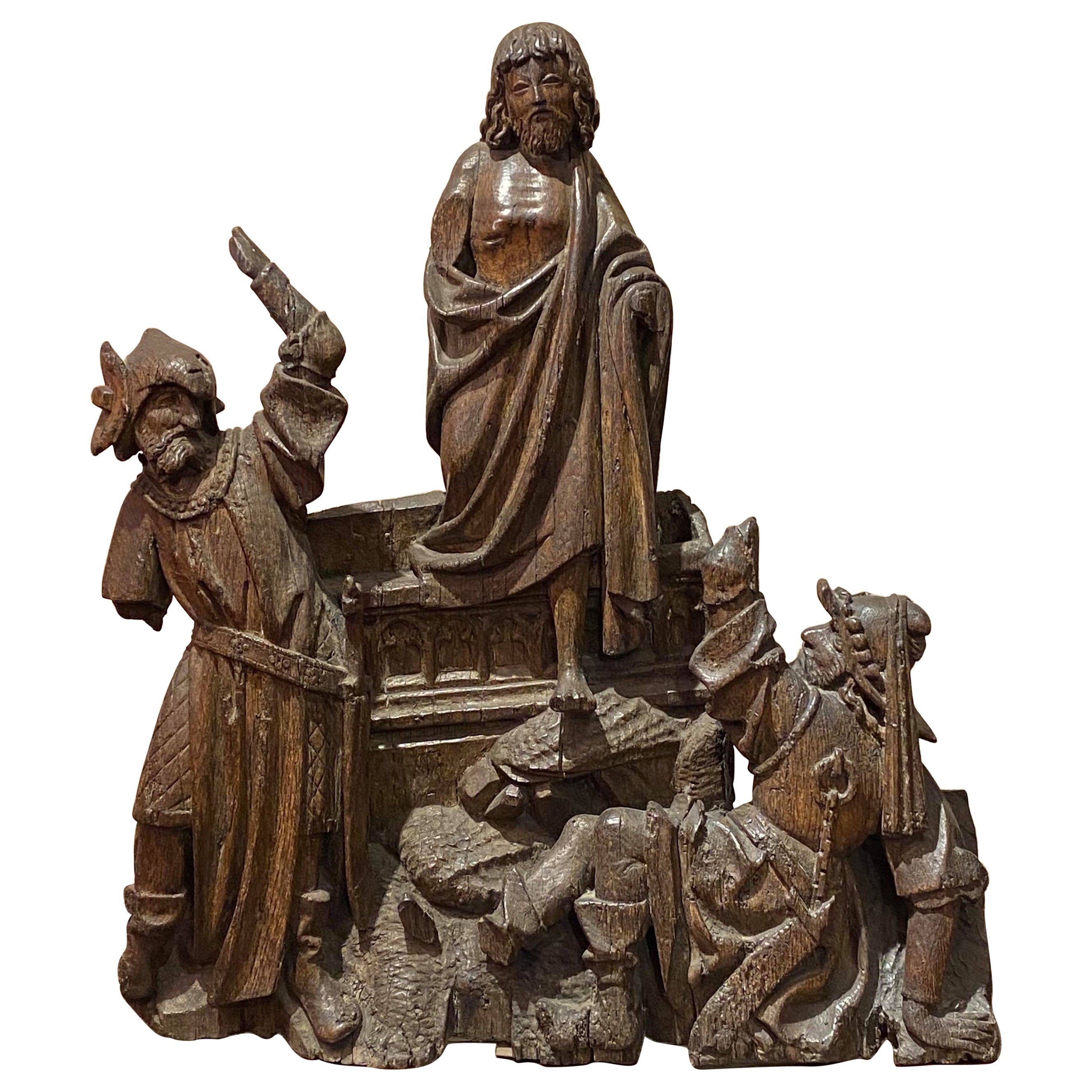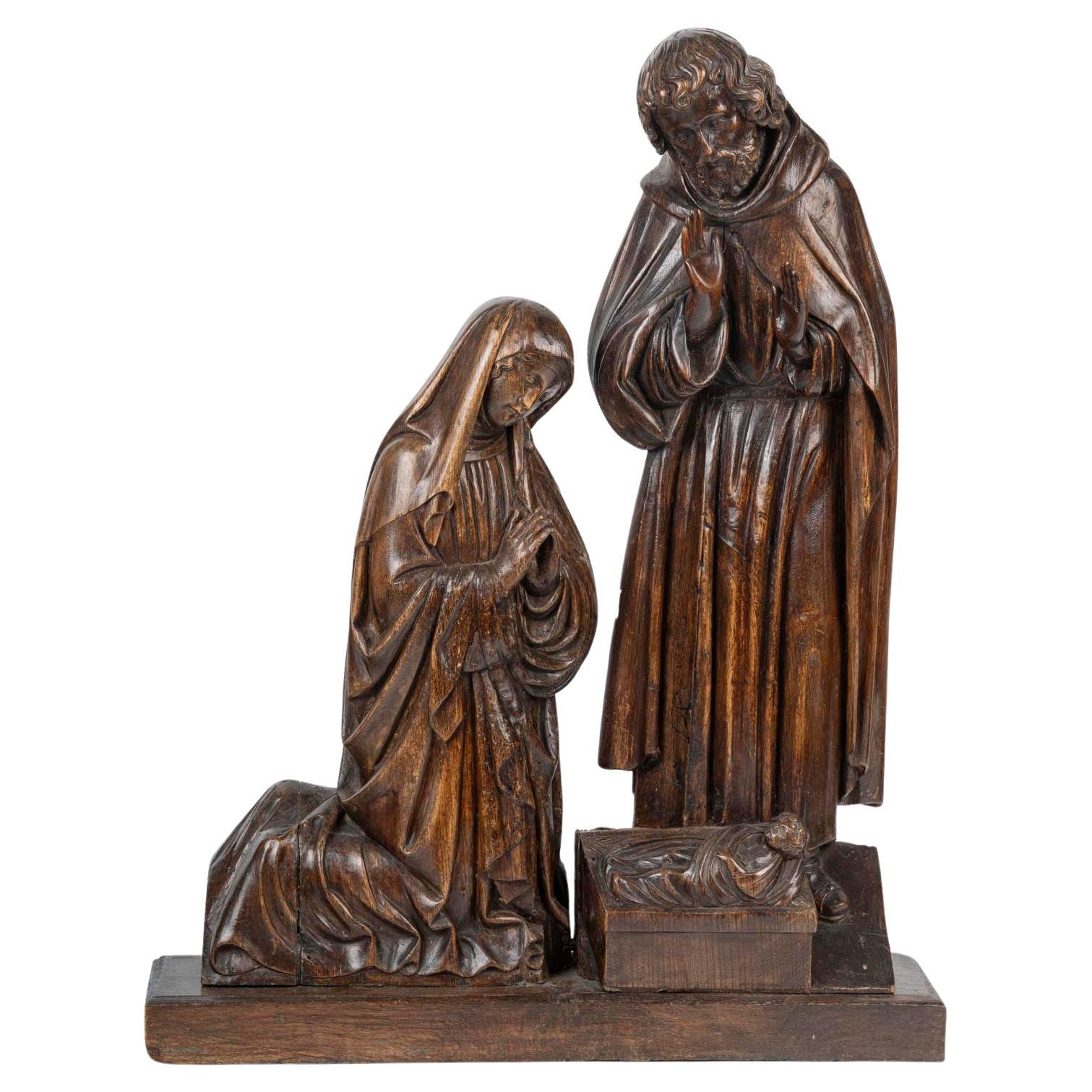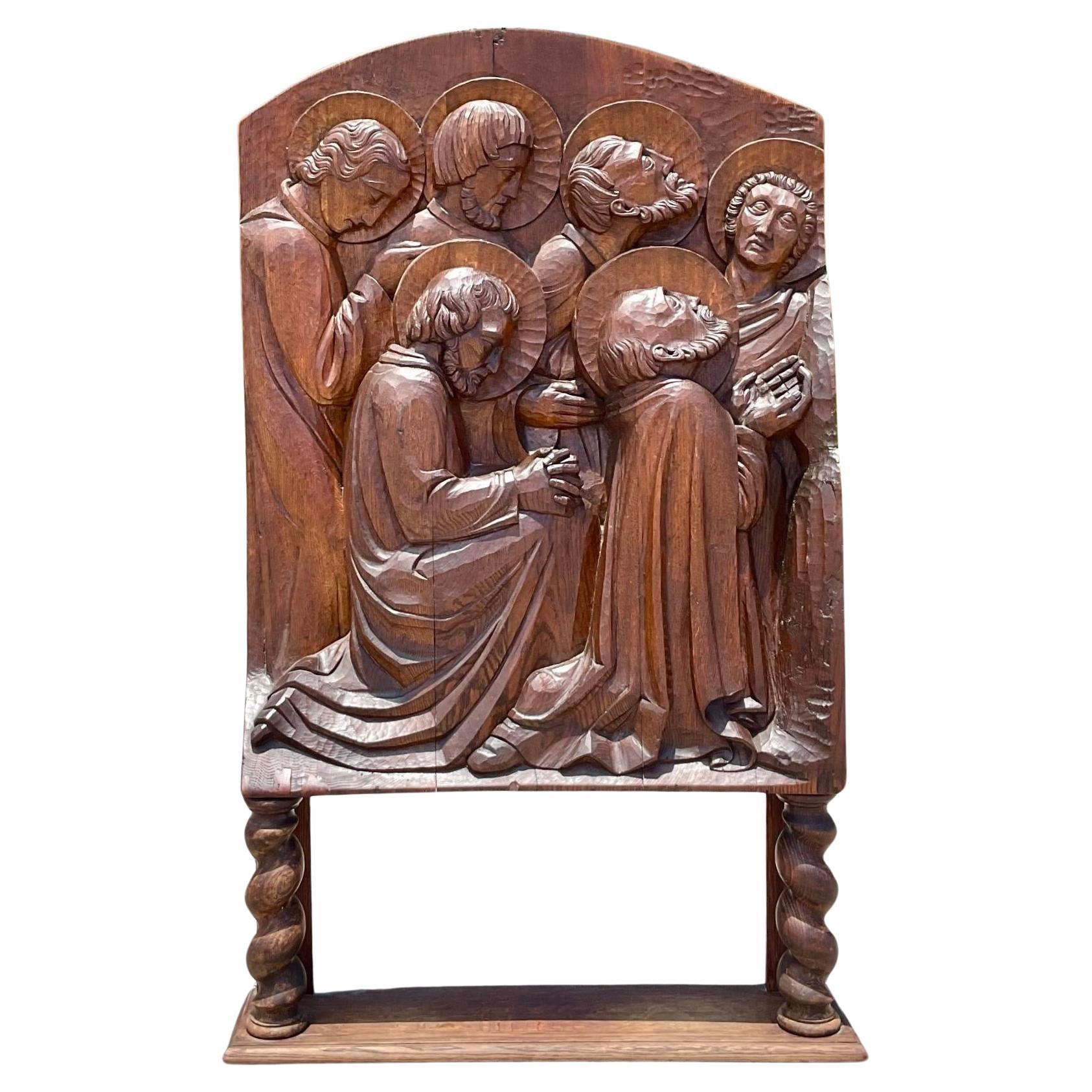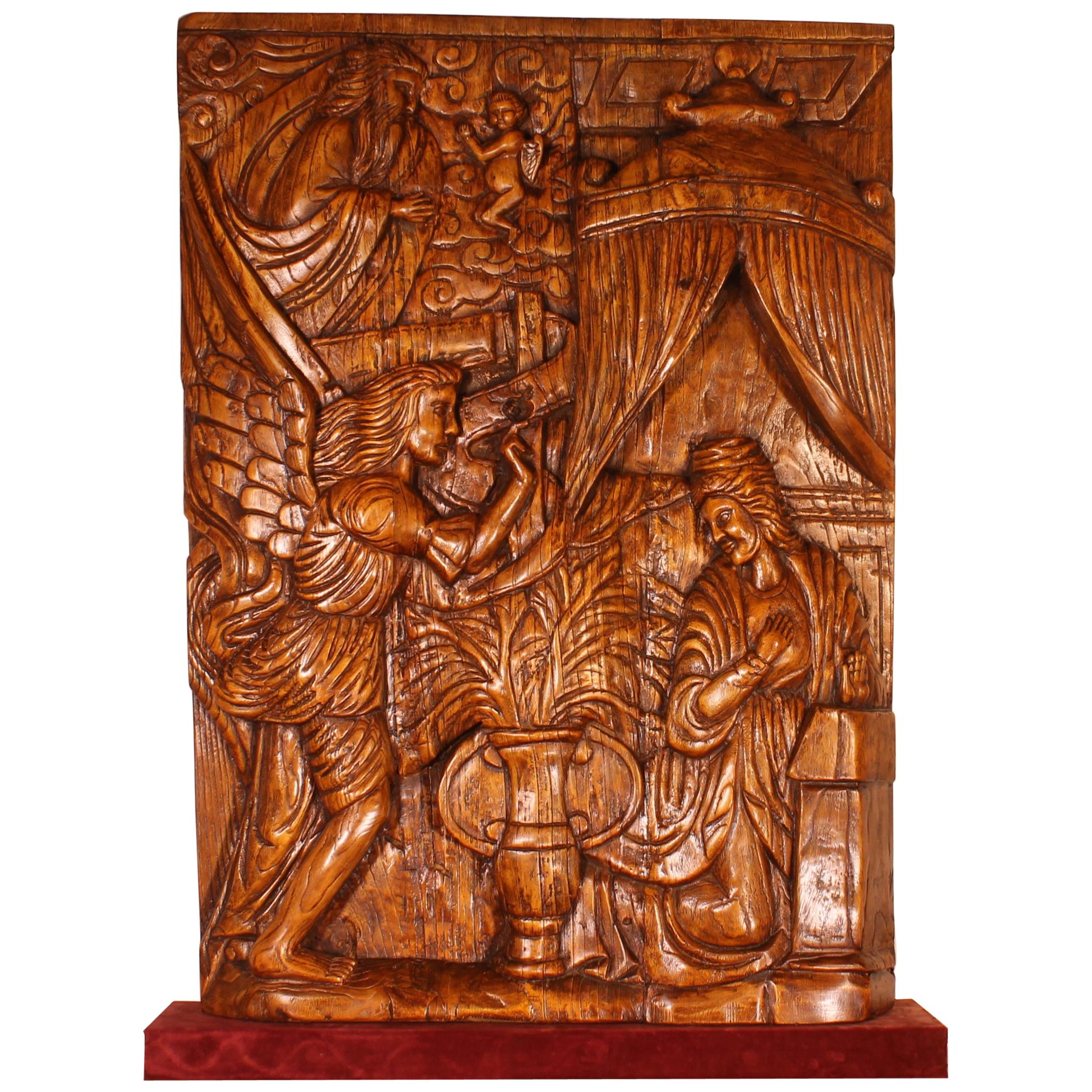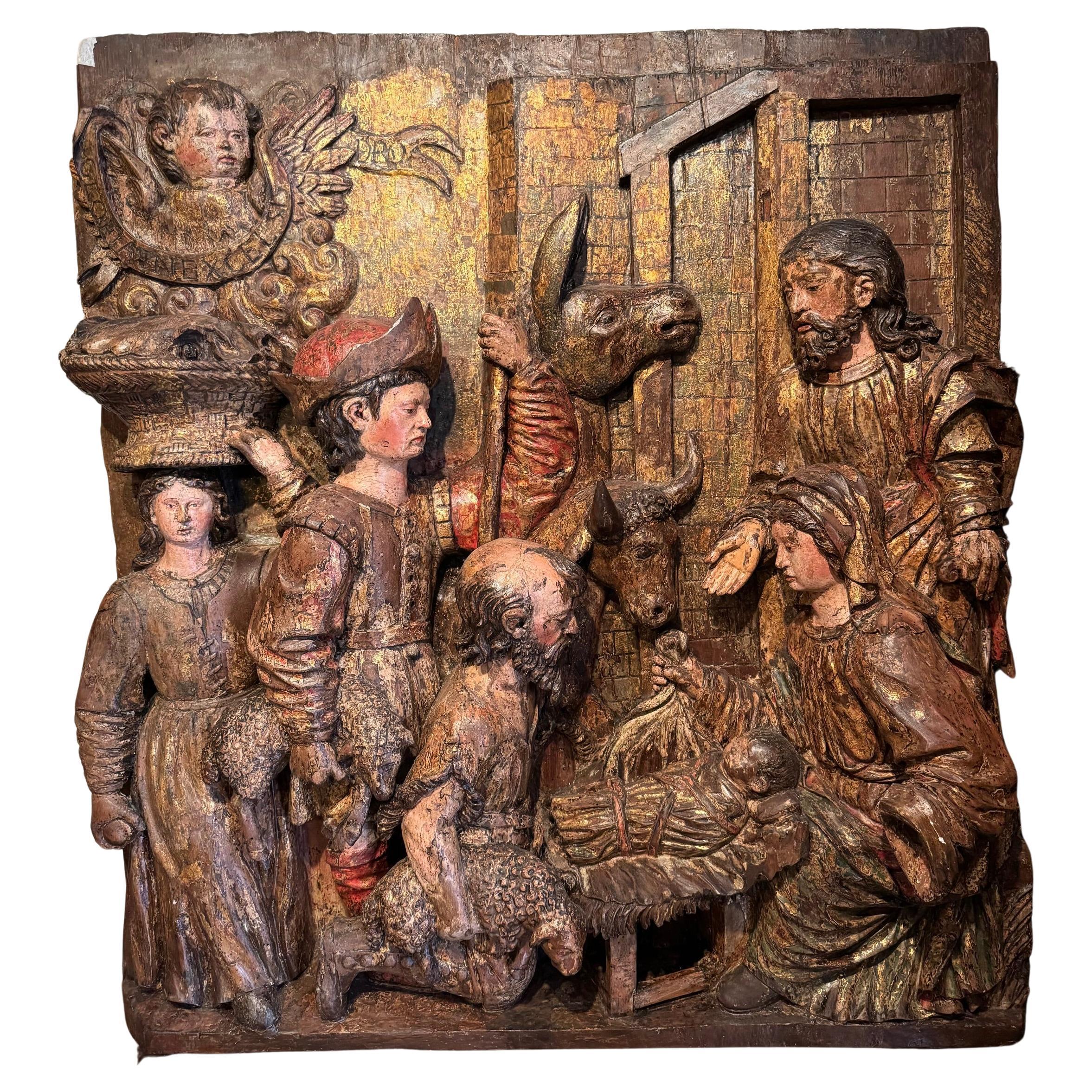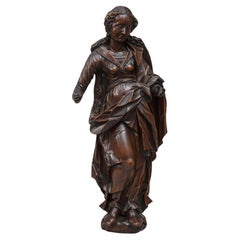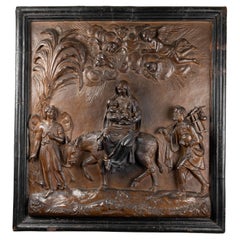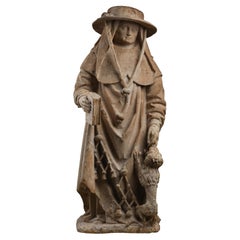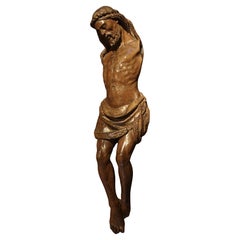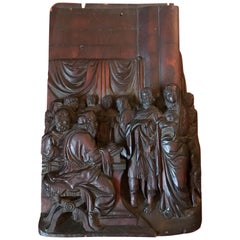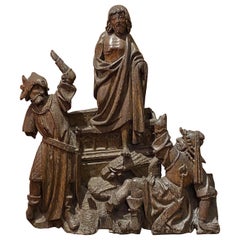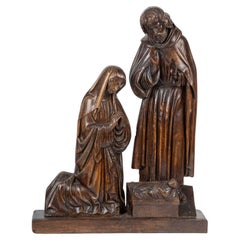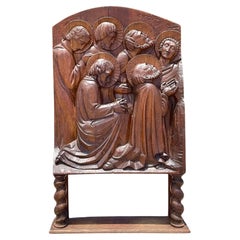Items Similar to Group of Altarpiece - Antwerpen, 16th century
Want more images or videos?
Request additional images or videos from the seller
1 of 6
Group of Altarpiece - Antwerpen, 16th century
$11,498.26
$19,163.7740% Off
£8,531.77
£14,219.6140% Off
€9,600
€16,00040% Off
CA$16,059.05
CA$26,765.0840% Off
A$17,416.42
A$29,027.3640% Off
CHF 9,147.76
CHF 15,246.2740% Off
MX$211,551.91
MX$352,586.5240% Off
NOK 114,469.79
NOK 190,782.9940% Off
SEK 107,779.70
SEK 179,632.8440% Off
DKK 73,135.21
DKK 121,892.0240% Off
About the Item
Group of altarpiece representing the life of a Saint, Saint Renualde?
Engraved by the sign of Antwerp hand on the hat of the central character
Carved oak, traces of polychromy
First half of the 16th century
31.5 x 39 x 6.5 cm
Under the rule of the dukes of Burgundy and the Habsburg, the former Low Countries experienced an exceptional economic boom in the 15th and 16th centuries, fostering a flourishing artistic activity within the major centers of the region. This was notably the case in Mechelen, Antwerp, and Brussels, which specialized in the production of large wooden altarpieces, depicting episodes from the life of Christ and the Virgin.
While Brussels dominated in the 15th century, Antwerp seemed to take precedence in the 16th century. At this time, Antwerp became the main port of Europe and the hub of a trade in which one of the essential components was the market for art and luxury objects. Around 1500, the production of altarpieces became massive, explained by several factors. On one hand, Antwerp sculptors and painters, belonging to the guild of Saint Luke unlike the Brussels artists, could collaborate more easily, as their production was strictly regulated in terms of wood quality and polychromy. On the other hand, Antwerp production was done in series, in advance, to be subsequently placed on the market. This offered greater freedom while allowing for standardization aimed at increasing the number of models produced. Finally, sculptors and painters were often affiliated with entrepreneurs responsible for selling the works wholesale to couriers, who then distributed the works throughout Europe.
The increasing number of altarpieces at the end of the Middle Ages and in the 16th century also reflects the evolution of piety in the former Low Countries, the cradle of the devotio moderna seeking a direct link with the divine. The 16th century, marked by political, social, and religious upheavals, saw in sacred art a crucial means of expressing the Catholic faith. Antwerp, as a bastion of Catholicism, became the center of intense artistic production, with wooden altarpieces being essential elements. In the domestic sphere, the contemplation of religious images facilitated personal meditation and provided access to spiritual experience. Lay or religious sponsors could install modest-sized altarpieces in an oratory or simply in a room, on a sideboard covered with a cloth serving as a private altar. Workshops in Brussels, Mechelen, and Antwerp produced numerous examples of such altarpieces, featuring various styles, compositions, and formats.
Guilds played a central role in this specialized production. They rigorously organized creation, precisely defining each technical element, from the choice of wood to that of pigments, and also determined who was responsible for which task. Each city affixed a certification mark on works created under its auspices, according to the rules it had established. The most famous of these marks is probably the Hand of Antwerp, which appeared around 1470 and is found on both sculpted elements and the very case of the altarpieces. The small hand (Handwerpen, detached hand), stamped in the wood with a red-hot iron, refers to a legend about a giant hand-cutter who terrorized the population before being defeated by the local hero, Brabant. Medieval sculptors from Antwerp were required to become members of the Guild of Saint Luke and had to abide by its regulations. When the jurors found that the requirements were met, an iron punch would imprint a mark in the wood.
The Antwerp origin of our sculpted group is thus confirmed and specified by the presence of a small hand, a "guarantee mark," applied with iron on the head of the central character. All indications agree to date the altarpiece to the first half of the 16th century, around 1530. The work corresponds to a certain peak of Antwerp workshops, combining quality materials, intensive production, and mastery of style. This is characterized by graceful elegance, somewhat affected in the representation of the characters. The simple craftsmanship, angular drapery, and stiff lines combine with the delicacy of expressions and finely featured faces. Our group is not only emblematic of Antwerp production certified by the red iron mark depicting a detached hand but also rare because it presents an unusual scene from the life of a local saint, unlike the dominant themes related to the Passion of Christ and the life of Mary. To the left, a woman with elaborate hair turns her back to the two male figures beside her. One, dressed in an apron, stands in the center, while a third figure, clad in a kind of armor and wearing only one shoe, completes the composition on the right. The men wear wide, short coats to the knees, with split sleeves leaving the forearms exposed. The woman, with a charming face and a high forehead, is wearing a veil with a short visor tied at the back. Her dress is split in front, revealing the underskirt; the neckline is square, and the sleeves are voluminous.
The composition, elaborate costumes, finely sculpted, as well as the variety of attitudes of the characters, are equally remarkable. The theatrical positions betray an influence of the Antwerp Mannerist style, suggesting a dating to the first half of the 16th century, in accordance with the hairstyles and hats of the characters. Concrete details and picturesque costumes reveal a typical taste of Brabantine works, but also of late Gothic art attached to expressive and narrative values.
It is possible that the scene depicted is drawn from the life of Saint Renelde. According to an ancient tradition, when her parents entered religious life, Renelde wished to join her father at the Abbey of Lobbes, which was denied to her. She then went to the Holy Land and, upon her return seven years later, withdrew from the world to settle in Saintes, a village in the Duchy of Brabant, with her two faithful servants, Grimoald and Gondulphe. She devoted herself to charitable works, and according to local tradition, miracles occurred at her tomb. Her body was exhumed in 866 and placed in a shrine, quickly making the site a place of pilgrimage. Saint Renelde is always depicted with her two faithful servants, Grimoald and Gondulphe, who were murdered with her.
The group presented was part of an altarpiece that, like many others, was dismantled during the iconoclastic revolutions, the dissolution of monasteries, and wars.
This meticulously sculpted work, intended for private devotion, describes with great attention to detail the facial features and costume details, such as the intertwining veil covering the head of the female figure, as well as the dress with puffy sleeves and accentuated folds.
Wooden altarpiece groups in Antwerp in the 16th century represent a pinnacle of Flemish sacred art. Their creation was the result of a tumultuous but artistically rich period, where spirituality and creativity intertwined to produce works that transcend time.
Related literature :
M. Buyle and C. Vanthillo, Retables Flamands et Brabançons dans les Monuments Belges, Brussels, 2000
G. Derveaux - Van Ussel, Retables en bois, Bruxelles, 1977, Musée Royaux d’art et histoire. Guide du Visiteur).
Huysmans ed., " La sculpture des Pays-bas méridionaux et de la Principauté de Liège XVe et XVIe siècles ", 1999.
S. Guillot de Suduiraut, Sculptures brabançonnes du musée du Louvre, Bruxelles, Malines, Anvers, XVe-XVIe siècles, Paris, 2001
H. Nieuwdorp (ed.), Antwerpse retabels, 15de-16de eeuw, exhibition catalogue, Museum voor Religieuze Kunst Antwerpen, 1993
P. Williamson, Netherlandish Sculpture: 1450-1550, cat. Victoria and Albert Museum, London, 2002
- Dimensions:Height: 12.41 in (31.5 cm)Width: 15.36 in (39 cm)Depth: 2.56 in (6.5 cm)
- Style:Renaissance (Of the Period)
- Materials and Techniques:
- Place of Origin:
- Period:
- Date of Manufacture:16Th century
- Condition:Wear consistent with age and use.
- Seller Location:Bruxelles, BE
- Reference Number:1stDibs: LU6666238315282
About the Seller
5.0
Vetted Professional Seller
Every seller passes strict standards for authenticity and reliability
1stDibs seller since 2022
15 sales on 1stDibs
Typical response time: <1 hour
- ShippingRetrieving quote...Shipping from: Bruxelles, Belgium
- Return Policy
Authenticity Guarantee
In the unlikely event there’s an issue with an item’s authenticity, contact us within 1 year for a full refund. DetailsMoney-Back Guarantee
If your item is not as described, is damaged in transit, or does not arrive, contact us within 7 days for a full refund. Details24-Hour Cancellation
You have a 24-hour grace period in which to reconsider your purchase, with no questions asked.Vetted Professional Sellers
Our world-class sellers must adhere to strict standards for service and quality, maintaining the integrity of our listings.Price-Match Guarantee
If you find that a seller listed the same item for a lower price elsewhere, we’ll match it.Trusted Global Delivery
Our best-in-class carrier network provides specialized shipping options worldwide, including custom delivery.More From This Seller
View AllStatuette of the Virgin, South German circa 1600
Located in Bruxelles, BE
Statuette of the Virgin
South-German, circa 1600
sculpted wood
circa 1600
(right arm restored)
52 cm
Category
Antique 17th Century German Renaissance Religious Items
Materials
Wood
Large Terracotta Relief - Lombardy, First Half of 17th Century
Located in Bruxelles, BE
Large Terracotta relief of the flight into Egypt
Lombardy, first half of 17th century
Painted terracotta
91 x 85 x 11,5 cm
This event in the early life of Christ is recounted i...
Category
Antique 17th Century Italian Baroque Figurative Sculptures
Materials
Terracotta
$62,282 Sale Price
20% Off
Followers of Jean de la Huerta, Jean de Blany ? - Saint Jerome
Located in Bruxelles, BE
Followers of Jean de la Huerta, Jean de Blany ?
Saint Jerome
Limestone
Burgundy, second half of the15th century
60,5 cm
ALR Ref : S00248050
This exquisite sculpture of Saint Jerome, carved from soft, nearly white limestone typical of eastern France, exemplifies the exceptional craftsmanship of 15th-century Burgundian art. The figure of Saint Jerome, a key figure in Christian history renowned for translating the Bible into Latin, is depicted wearing a cardinal’s hat and holding the Vulgate Bible...
Category
Antique 15th Century and Earlier French Renaissance Figurative Sculptures
Materials
Limestone
Christ - Umbria, second half of the 15th century
Located in Bruxelles, BE
Christ
Umbria, Orvieto?
Second half of the 15th century
77 x 16.5 cm
Category
Antique 15th Century and Earlier Italian Renaissance Figurative Sculptures
Materials
Walnut
$7,635 Sale Price
25% Off
Cercle of Romano Alberti, Page, Around 1530-1540
Located in Bruxelles, BE
Cercle of Romano Alberti, dit Il Nero da Sansepolcro ( San Sepolcro, 1521-1568 )
Page
Mixed media : wood core, papier mâché, stucco, polychrome and gilded
Italy, around 1530-154...
Category
Antique 16th Century Italian Renaissance Figurative Sculptures
Materials
Stucco, Wood, Paper
$12,456 Sale Price
35% Off
renaissance wooden candelabrum and painted cross - Umbria, 16th century
Located in Bruxelles, BE
Base of a carved wooden candelabrum, polychrome and gilded; cross painted on both sides.
Umbria or Tuscany, 16th century
136 x 43,5 x 30 cm
(The cross and the base of the candelabrum were later assembled)
The base of the candelabrum is intricately carved and adorned with polychrome and gilded finishes. The shafts take on the shape of balusters reminiscent of ancient columns, feature ornate foliage decorations, garlands and winged cherub faces. The feet are crafted in the likeness of lion paws. The base is further embellished with depictions of four saint martyrs, among them Saint Barbara and Saint Catherine of Alexandria. The plasticity of the figures, outlined with strong contour lines, the clear and vibrant colors, are stylistic elements linked to the Umbrian tradition of the sixteenth century.The precisely defined and elegant drawing, along with the clear color palette applied with refined chiaroscuro modulations, became the signature of a style that would leave a lasting mark on the era to come. This is exemplified by a preference for vibrant, multicolored images, accentuated in this case by the use of red and pink in the saint's attire.
A notable addition, introduced later, is a polylobed cross painted on both sides. On one side, the Crucifixion is vividly portrayed:The treatment of the corpus itself is in line with High Medieval practice, emphasizing pathos by showing Jesus dead, his arms sagging from the weight of the body. The upper section displaying a pelican pecks at her breast to feed her young with her own blood; a symbol of the sacrifice of Christ on the cross whose body and blood similarly nourishes the celebrant during Mass.
The lower part depicts Golgotha. On the reverse side, the Resurrection is artistically presented in a Renaissance iconography, reminiscent of the renowned composition painted by Piero della Francesca, now housed in the Civic Museum of Sansepolcro. In terms of composition, with the frontal depiction of Christ holding the banner, this motif became particularly widespread in central Italy, spanning from Tuscany to Umbria throughout the 16th century..
The double-sided construction suggests that it may also have been carried in liturgical processions. In Umbria from the 14th century, the use of portable crosses painted on both sides had become a widespread practice, aimed at satisfying the monastic clientele that had significantly increased following the establishment of new religious communities.
The earliest surviving Tuscan painted crucifix represent Christ as Christus Triumphans, or the “Triumphant Christ” with his head up and eyes open. This form was supplanted in the 13th century with the Christus Patiens, or “Suffering Christ” type who is shown often with his head fallen on his shoulder and his eyes closed, as In our cross. The iconography of the suffering Christ appears to have developed out of a new interest in Christ’s human nature, the development of the feast of Corpus Christi and with increased importance given to the Eucharist. The process of humanizing the figure of Christ reaches its peak with the abandonment of all the previous expressive conventions in favor of more realistic details we can observe in this Crucifix, such as the swollen belly, the arms stretched to the limit of muscle tearing, the body falling heavily forward, the abundant blood on
the wounds, and the cross firmly embedded in the rock of Calvary.
It's worth noting that Renaissance candelabra...
Category
Antique 16th Century Italian Renaissance Figurative Sculptures
Materials
Wood, Giltwood
You May Also Like
17th Century Early Baroque Flemish Wood Carved Religious Figural Group
Located in Vero Beach, FL
This rare 17th century panel, carved in high relief, is museum quality and without doubt the work of an important Flemish master carver. It represents the biblical scene of Mary and Joseph in Bethlehem for the census. Multiple figures surround the center in a well balanced setting. Rich, deep color and great patina, which developed over about 400 years, make this piece of art exceptional. The panel is mounted on a later dusty rose velvet backing.
Condition: Small part of backdrop on right is missing. Joseph’s left hand is missing.
Measurements:
Image size - 8 ½” W x 12 ¼” H x 2” D
Back panel - 10 ¼” W x 14” H x ½” D
Entire piece - 10 ¼” W x 14” H x 2 ½” D
Weight: 2 lbs. 8 oz.
Category
Antique 17th Century Belgian Baroque Religious Items
Materials
Wood
$4,280 Sale Price
20% Off
Carved Wood Depicting the Resurrection of Christ
Located in Saint-Ouen, FR
Carved wood depicting the resurrection of Christ
ORIGIN : SOUTHERN NETHERLANDS, ANTWERP
PERIOD : EARLY 16th CENTURY
Height : 67.5 cm
Len...
Category
Antique 16th Century Figurative Sculptures
Materials
Oak
Religious Sculpture Representing the Nativity, Carved Wood from the 16th Century
Located in Saint-Ouen, FR
Religious sculpture representing the nativity, carved wood from the 16th century.
Carved wood sculpture, walnut wood and oak wood base, sculpture representing the nativity, circa 16...
Category
Antique 16th Century French Neoclassical Figurative Sculptures
Materials
Oak, Walnut
Vintage Boho 19th Century Carved Saints Floor Sculpture
Located in West Palm Beach, FL
Infuse your space with spiritual elegance through this vintage boho 19th-century carved saints floor sculpture. Masterfully crafted with intricate details...
Category
Antique 19th Century American Figurative Sculptures
Materials
Wood
$2,280 Sale Price
20% Off
Altarpiece Representing The Annunciation, North of Portugal, circa 1600
Located in Brussels, Brussels
Exceptional altarpiece representing the annunciation circa 1600, fruitwood
rare altarpiece from the North of Portugal, unique due to its large size representing the scene of the annunciation, where the Archangel Gabriel (represented on the bottom left), sent by god (represented on the top left) announces to Marie (bottom right) that she will give birth to Jesus.
Very good state of conservation, carved on three panels
Dimension: Height 1m51
Width 1m03
Very nice colour and exceptional dimensions
Restorations of use
We placed the altarpiece on a red velvet base and a Spanish occasional...
Category
Antique 17th Century Portuguese Renaissance Figurative Sculptures
Materials
Fruitwood
Adoration of the shepherds - Large high-relief, Northern Italy Circa 1500
Located in PARIS, FR
Large high relief in carved and gilt wood, with many traces of polychromy, representing the Adoration of the Shepherds.
The evangelist Luke first mentions that the scene takes place at night. A sudden light, which frightens the shepherds, signals the arrival of an angel who announces "great joy". He gives them a sign: they will find "a newborn baby wrapped...
Category
Antique 16th Century Italian Renaissance Figurative Sculptures
Materials
Wood
More Ways To Browse
Antique Oak Coat And Hat Stand
15th Century Polychrome Sculpture
18th Century Wood Cherubs
19th Century Male Nude Bronze
African Sculptures Large
Antique Bacchus
Face Mask Sculpture
Hagenauer Wood
Iron Tree Sculpture
Italian Woman Nude
Lalique Car Mascots
Life Size Female Sculpture
Little Figurine
Male Athlete
Mechanical Sculpture
Murano Glass Pear
Nude Male 19th
Pineapple Sculpture
